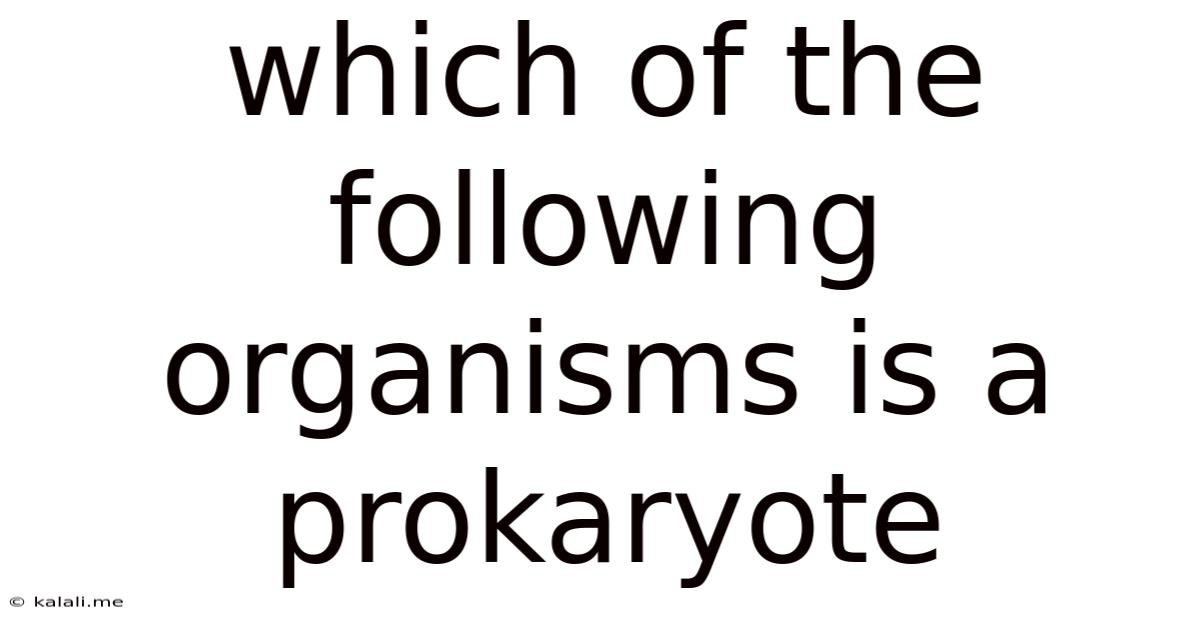Which Of The Following Organisms Is A Prokaryote
Kalali
Jun 13, 2025 · 3 min read

Table of Contents
Which of the following organisms is a prokaryote? Understanding Prokaryotic and Eukaryotic Cells
This article will delve into the fascinating world of cells, specifically addressing the question: which of the following organisms is a prokaryote? Before we answer this, let's understand the fundamental differences between prokaryotic and eukaryotic cells. This knowledge is crucial for classifying organisms and understanding their biological processes. This article will cover prokaryotic cell structure, eukaryotic cell structure, and examples of each, helping you confidently identify prokaryotes in the future.
What are Prokaryotes?
Prokaryotes are single-celled organisms that lack a membrane-bound nucleus and other membrane-bound organelles. Their genetic material (DNA) is located in a region called the nucleoid, which isn't separated from the rest of the cytoplasm by a membrane. This simple cellular structure distinguishes them from eukaryotes. Prokaryotes are generally smaller and simpler than eukaryotes. They represent the earliest forms of life on Earth and include bacteria and archaea. Key characteristics include:
- Absence of a nucleus: Genetic material floats freely within the cytoplasm.
- Smaller size: Typically ranging from 0.1 to 5 micrometers in diameter.
- Simpler structure: Lacking complex organelles found in eukaryotes.
- Single-celled: Existing as individual organisms, although they can form colonies.
- Ribosomes present: These are responsible for protein synthesis, but they differ in structure from eukaryotic ribosomes.
- Cell wall present (usually): Provides structural support and protection.
What are Eukaryotes?
Eukaryotes, on the other hand, possess a membrane-bound nucleus that houses their genetic material. They also contain various other membrane-bound organelles, each performing specialized functions within the cell. These organelles include mitochondria (the powerhouses of the cell), the endoplasmic reticulum, Golgi apparatus, lysosomes, and more. Eukaryotes are significantly more complex than prokaryotes and can be single-celled or multicellular. Key characteristics include:
- Presence of a nucleus: Genetic material is enclosed within a membrane-bound nucleus.
- Larger size: Typically ranging from 10 to 100 micrometers in diameter.
- Complex structure: Possessing numerous membrane-bound organelles.
- Single-celled or multicellular: Can exist as individual cells or form complex multicellular organisms (like plants and animals).
- Ribosomes present: Larger and structurally different from prokaryotic ribosomes.
- Cell wall present in some (plants, fungi): Provides structural support, but not universally present.
Identifying a Prokaryote from a List
To determine which organism from a given list is a prokaryote, look for characteristics like the absence of a nucleus and other membrane-bound organelles. If the organism is described as bacteria or archaea, it's almost certainly a prokaryote. Organisms like animals, plants, fungi, and protists are eukaryotes.
Examples:
- Prokaryotes: Escherichia coli (E. coli), Salmonella, Cyanobacteria
- Eukaryotes: Humans, Yeast, Amoeba, Plants, Animals
Therefore, without a specific list of organisms, a definitive answer to "which of the following organisms is a prokaryote?" cannot be provided. However, armed with the knowledge of prokaryotic and eukaryotic cell structures and examples, you can easily identify prokaryotes when presented with a list of organisms. Remember to look for the key characteristics: absence of a nucleus and other membrane-bound organelles, smaller size, and simpler structure.
Latest Posts
Latest Posts
-
Stp S16 Oil Filter Fits What Vehicle
Jul 01, 2025
-
Which One Of The Gatlin Brothers Passed Away
Jul 01, 2025
-
Do Naked And Afraid Contestants Get Paid
Jul 01, 2025
-
How Many Bottles Of Water Is 64 Oz
Jul 01, 2025
-
Was Brigham Young Stabbed By One Of His Sons
Jul 01, 2025
Related Post
Thank you for visiting our website which covers about Which Of The Following Organisms Is A Prokaryote . We hope the information provided has been useful to you. Feel free to contact us if you have any questions or need further assistance. See you next time and don't miss to bookmark.